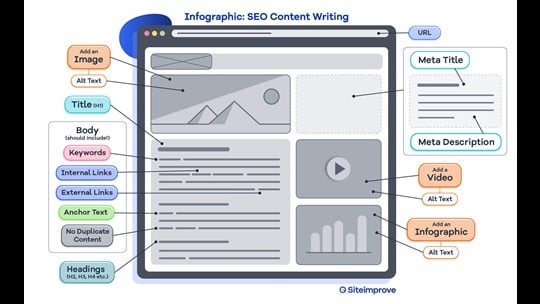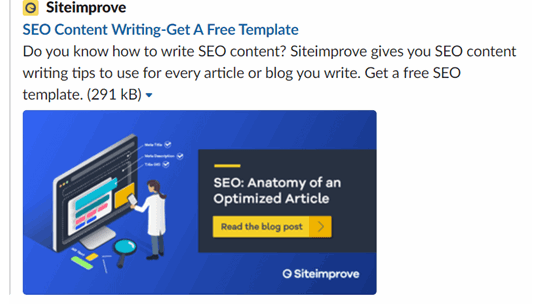SEO content writing-get a free template
- By Siteimprove - Jul 09, 2019 SEO
In the spirit of full transparency, we’ve written this blog with no secrets. We optimized every aspect for search engines so that we drive more traffic to our website. SEO content writing makes a world of difference in whether our post is seen or not.
You probably already knew that.
You may not, however, know the number of ways it’s been optimized—or the whys behind those decisions.
Like every B2B organization, Siteimprove drives traffic through agile content marketing and on-page optimization (among other things). Clever SEO copywriting leads to great blog optimization. Great blog optimization translates to increased website visitors. And more visitors expose our product to more eyes—which ultimately drives conversions. That’s why when we write, we always optimize!
In this blog, we examine the SEO actions we took to boost ranking—each with a corresponding number so you see where they occur. You’ve heard of paint-by-numbers? We’re calling this optimization by numbers.
Step 1. We started with keyword research for SEO content writing
The starting point for this blog post—like every other—was keyword research. Before we began writing, we selected a topic. In this case, it was ‘how to write SEO content’. That subject was eventually refined down to ‘SEO content writing’. We then jumped onto the Siteimprove platform.
Siteimprove’s SEO tool guided us to the right keywords. It compiled data and analytics from millions of searches and offered keyword suggestions (which we’re using now). For any B2B, middle-market or enterprise organization, a content writing tool is invaluable in keyword planning.
Our target, keywords are ‘SEO content writing’. We found several related, or semantic, keywords. Here’s a snippet: ‘SEO content writing samples’, ‘SEO content writing tips’, ‘SEO content writing tools’, ‘how to write SEO content’, and ‘SEO content writing template’. You’ll run across several of these terms throughout this article.
Step 2. We wrote SEO-friendly headings to aid content writing
Each section of this article is separated by a heading. These headings serve a serious purpose: to spell out what the section is about. Not only do headings create better digital accessibility for people using screen readers or assistive devices, they tell both users and search engines what the overriding theme of the section concerns. Search engines place a heavy emphasis on your page’s H2s.
Step 3. We peppered “SEO writing” keywords throughout
Remember, when we said that we let the SEO tool do the work of keyword suggestions? This is where those keywords come into play. Relevance and originality of content are always top priority, but we pepper our target keyword and semantic keywords throughout. We only do this where it makes sense, however!
We already know which terms people are searching for because our keyword research told us. When we find a place where those terms relate to a section of the blog post, we add them in. One thing we DID NOT DO was keyword stuffing. This is the practice of overusing target keywords throughout the blog post where they’re not relevant. Amateur tactics like hiding keywords as part of a background image are also a big no-no. Every term we use correlates to the subject in a logical way.
Step 4. We followed the primary rule for all SEO copywriting: Originality
Siteimprove develops SEO solutions, so we write about SEO a lot. It is, after all, one of our most popular products.
Many of our blog posts have similar topics, but the focus of every article is always different. We do not duplicate material from blog post to blog post, we design original images, and we never duplicate meta titles or meta descriptions. Those things would negatively impact our SEO.
When a content writer or web editor posts previously published content, it effectively tells search engines that their website lacks originality and freshness. If you want to lead the pack in search engine rankings, strive to be an authority by producing original content not found elsewhere on the internet. By the way, the no-duplication rule also applies to content found elsewhere on your own website.
Step 5. We paid attention to internal links, external links, and anchor text
We, of course, added links to this blog post when referencing sources or statistics. There are links to Hubspot, Siteimprove, Search Engine Watch, Google, etc. We set these links to open in a new window as it’s a good way to ensure readers don’t lose their place in our article.
Linking to popular or big-authority websites boosts your own site. Add links—but not too many! After all, you don’t want to redirect a reader off your website only to get distracted by other content and never finish your article.
Anchor text can and should be optimized—but not over-optimized. Anchor text is the clickable string of text that leads to another webpage. Google ‘reads’ anchor text as an indicator of what the page is about. However, anchor text on its own is not everything. Google also considers the content surrounding the anchor text in assessing relevance of a page. While there’s ongoing debate about the benefit of using exact match keywords or partial match keywords, it’s best to create natural text as an anchor. We use a mix of keyword matching and natural wording to form the anchor text throughout our articles.
Step 6. We added accessible and SEO-friendly alt text to images
We added alt text to our hero image, the circle icon you see alongside the blog when it’s listed on the main blog page, the meta image, and any images embedded directly into the article.
Adding alt text makes our site more accessible, as it tells screen reader users what each image is about.
Adding alt text also makes it easy for search engines to understand what the image is about. If a searcher is looking for red high-heeled shoes, and your site has them, make sure that information is communicated to the search engine crawlers.
Step 7. We created an infographic on SEO content writing
In order to make this blog richer and provide a visual picture of what we’ve written about, we added an infographic. Having an infographic on your website is a big, positive boost for your SEO:
- Originality
Search engines like content that’s not been seen before. An original infographic presents information in a format that you (hopefully) put together yourself. - Effort
Content that takes work to create gives a positive SEO benefit.
Text= Easy
Video= Less Easy
Infographic= Hard - Social Traffic
An infographic is one of the most shareable pieces of content. It provides information in a concise and visual way that’s easy to digest. Every time someone shares your infographic, you enhance your opportunity for a backlink. Although a social share is not a ranking factor directly, it increases the chances of others linking to it which is SEO-beneficial. Anytime someone adds a backlink to your site, you earn SEO credit. Backlinks are pure gold in SEO.

Step 8. We optimized the URL with our main keyword
The URL is always one of the top SEO factors to pay attention to. Our target keyword is ‘SEO content writing’, so we used that as the URL name. The URL should contain terms you want to be indexed for.
Use hyphens to separate words instead of underscores. Hyphens are the standard and search engines prefer them.
Step 9. We wrote the meta title & description
The meta title and description are not seen in the actual article, but in SEO they play extremely important roles. They tell search engine crawlers what your page is about and provide the snippet of summary that users see when doing a search. Google’s blog compares it to a book synopsis. Meta titles and descriptions are also visible when people share your post.
Because the meta title is one of the most important on-page SEO factors, your main keyword should be a part of it. It’s also smart to add your main and/or related keywords to the meta description.
We’re calling this step number nine, but it can actually come anywhere in the process. Once you have a clear direction of your article topic and keywords, you can easily write the meta title and meta description. The meta title should be short and attention-grabbing. Use your keywords where you can.
Keep in mind that your meta title shows up in the tab and a long meta title will be truncated if a user has many tabs open. You don’t want your page name cut off if you can help it. Remember, these elements are what’s seen when people share your content on LinkedIn, Facebook, or other websites. It’s also the organic descriptions from which the search engines pull snippets when your site shows up in their results page.
This is what our meta description looks like typed out:
Meta Title: SEO Content Writing-Get A Free Template
Meta Data: Do you know how to write SEO content? Siteimprove gives you SEO content writing (20) tips to use for every article you write. Get a free SEO template.
This is what our meta description looks like when you share this article:

On-page SEO involves many elements. The moving parts operate to build your company’s portfolio with search engines. By explaining Siteimprove’s optimization techniques we hope to further demystify SEO.

